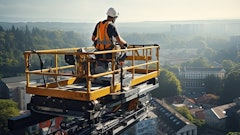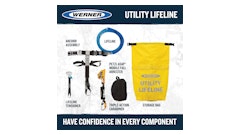
On construction worksites, workers in 3 out of 10 companies are at risk of hearing loss – but many who could otherwise prevent hearing loss believe they've just “gotten used to the noise.” The truth is that construction workers experience the second highest rate of occupational exposure to noise hazards – increasing the risk of noise-induced hearing loss.
No matter what precautions are taken, construction sites host numerous noise hazards. Often it is unclear what level of hearing protection is needed since the jobs conducted and tools used vary within a shift or project, along with the noise hazards. It’s important for managers to efficiently monitor and mandate hearing protection for on-site construction workers by following a few crucial steps in training and preparation. Honeywell
Honeywell
Construction noise hazards are everywhere when working on-site, but taking the proper precautions can mitigate risk, prevent injuries and save lives. Fortunately, there are many ways to protect worker hearing, including a variety of earmuffs and ear plugs that can be used from the simplest to most complicated tasks.
While a wide variety of hearing protection options is beneficial, it can make the quest for the best fitting hearing protection devices (HPD) more difficult. So, what are the best practices for construction managers to effectively implement on-site hearing protection?
Train workers to assess noise risk . . .
Construction sites present several forms of noise hazards with varying levels of risk. When looking to determine the best hearing protection for a dangerous environment, managers must first identify the equipment that is causing noise exposure to understand the levels of risk associated with each piece of equipment. Whenever possible, immediately eliminate or reduce extreme noise levels, or offer workers suitable HPD.
For reference, any noise above 85 decibels (dB) has potential to cause long-term hearing loss. Some examples of common noise hazards on-site are when using a bulldozer (100 dB) and a chain saw (110 dB). Impact-noise exposures are enough to be harmful too. Repeated short spurts of noise, such as hammering in a nail (120 dB), can cause hearing damage. Honeywell
Honeywell
If a worker's HPD does not fit properly, it cannot properly provide protection. An eighth of an inch can be the difference between receiving the stated level of protection based on the noise reduction rating on an earplug and getting no protection at all. Comfort and fit go hand in hand when talking about safety equipment. Ear-plug fit testing systems provide real-world metrics to help managers understand if employees are receiving optimal protection for the noise environments in which they work.
Another aspect to consider when choosing the right HPD for construction workers is its compatibility with the variety of other protective equipment that keeps them safe – safety headwear, eyewear, clothing, shoes, gloves. Thus, selecting personal protective equipment (PPE) that does not compromise the operation or efficiency of another PPE is quite important. For instance, safety eyewear with thick frames (6mm) can cause a gap between the wearer’s head and earmuffs, providing an easy way for sound to penetrate the earcup, and reduce optimal attenuation by 2 decibels. In this situation, ear plugs would be the best-fit HPD based on all the PPE required to do the job.
It is worth noting that any HPD that blocks sound 100% is also considered unsafe and not compatible for construction site use because it can increase other risks. While hearing protection is crucial, a worker who cannot hear the warning signal of a truck or piece of heavy equipment coming their way may be in more danger. Workers who cannot hear (and therefor, cannot communicate effectively with peers) are also more likely to make mistakes and tend to feel more isolated on the job. Honeywell
Honeywell
Prepare for future HPD
While the options of HPD seem to be endless, the US industrial hearing protection market is expected to surpass $650 million by 2024, according to a report by Global Market Insights. This boom in hearing protection technology will not only offer more devices to protect workers from hearing loss, but also add innovative technologies to advance the purpose and benefit of hearing protection.
For example, employers can integrate technology that allows for remote noise monitoring, performing annual audiometric screenings and hazard training on the irreversible impact of noise-induced hearing loss. For workers in noisy environments, new sound technologies embedded in connected earmuffs monitor sound exposure continuously and adjust in-ear volume to safer levels so the worker can communicate clearly.
The main use case for hearing protection will always be safety, but other features can help cultivate a better overall work environment. For example, studies show that ear protection with technologies such as integrated stereo sound can make workers more productive and motivated on the job.
Product innovations that utilize these modern technologies allow workers to be more responsive in the event of a safety issue and empower them to proactively mitigate or prevent future safety hazards. In doing so, workers are given more control over their safety in the workplace, both for immediate and long-term health.
Maintain construction workers health and productivity
While hazardous noise may not cause adverse effects at the time of exposure, the cumulative effects of ongoing exposure to hazardous noise can gravely impact long-term hearing. Construction workers whose jobs regularly involve loud machinery and tools to get the job done are particularly in need of hearing protection as a crucial element in ongoing occupational safety programs.
For leaders in the construction field, assessing the noise risk on jobsites and training workers to understand the importance of properly-fitting, comfortable and job-compatible hearing protection is more than just a “nice-to-have,” it is an investment in the health, longevity and productivity of workers.



























